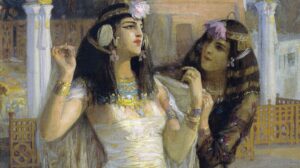Genghis Khan, although the product of an illiterate and barbarous people plagued by internecine wars, transformed the Mongol warriors into a brilliant military machine that frequently defeated the civilizations of China, Islam, and Eastern Europe. Legend claims that Genghis Khan was born with a clot of blood clutched in his hand, an omen of greatness. Regardless of omens, the cruel, creative, and cunning mind of Genghis Khan clearly was responsible for his truly legendary success.
For example, in 1207 when his Mongol army had been stymied by the fortified city of Volohai, he proposed to the city leaders that he would end his siege if they paid him a bizarre tribute of 1,000 cats and 10,000 swallows. The strange demand was met by the city and then Genghis Khan told his Mongols to tie tufts of wool to the tails of the animals and set them on fire. Terrified by the burning bits of wool, the cats and swallows were released. They fled back to their lairs and nests within the city and spread fire throughout the walls. The Mongols then successfully stormed the walls of Volohai while its defenders were occupied with the many fires. Another tactic employed by the Mongols during one of their many campaigns against the Chinese was to round up women, children, and elderly from the countryside and drive them before their army as a human shield so that the defenders of walls would not shoot.
Despite his cleverness, Genghis Khan realized that he could not depend on trickery forever. He needed to address the weaknesses within the Mongol army. The equipment and techniques of sieging needed to be added to the swift and bloodthirsty Mongol hordes.
Genghis Khan was always willing to learn from the civilizations that he conquered, including the arts of war. He commanded each tribe under him to assemble siege equipment and learn how to use it and transport it. In addition to these technical advances, he formed an elite corps of professional commanders who were to devote themselves to training for warfare. This innovation in his command structure surmounted the long standing tradition of Mongol warriors who, despite their vicious skills, were amateurs. They would follow orders as long as victory was forthcoming, but they grew restless in the face of setbacks or failure. Wanting only easy plunder, the traditional Mongol warrior had not applied himself much to long term strategies. The new command corps would provide the structure and discipline needed to transform the Mongol warriors into a multi-skilled and adaptive force.
Genghis Khan also understood that a military is supported by its society, and he allowed Mongol civil society to advance with the aid of codified laws that he bade his advisor and scribe Tatatungo to write. The newly written Mongol code called for all men to work and to always be ready for battle, stated that even a leader was subject to law, insisted that all religions should be tolerated and even respected, and that the rights and responsibilities of women over the management of family assets should be greatly expanded. This inclusion of women in the management of society as opposed to total oppression allowed Mongol society to function while the men were away at war. Genghis Khan was not one to allow strict patriarchy to weaken his army. His codification and enforcement of written laws also promoted discussion and judging within Mongol society to settle disputes instead of the petty wars that had permanently raged for countless generations. With Mongol society now enjoying a greater level of peace, it could better maintain the engines of conquest.
With the natural talents of the Mongol warriors now enhanced by strategic thinking, professional leadership, and siegecraft technology, the many kingdoms of Asia would soon crumble beneath the hooves of the nomadic masses turned conquerors. Even with such might at his disposal, Genghis Khan did not deal blows thoughtlessly. He is well known for his astute use of terror. He cultivated such a frightful reputation that cities and kingdoms would surrender to him instead of suffer the assault of his bloodthirsty hordes. Genghis Khan required total and immediate submission in order to bestow his mercy. Any resistance invited brutal horrors. Although there is no condoning the slaughter and pillaging of his armies, his conscious use of terror was a well thought out practice that often brought him an efficient victory without having to spend the lives of his soldiers and waste resources and time.
The Mongols under Genghis Khan were such a colossal force that resistance was almost always futile. The fierce and highly skilled Mongol warriors seemed to have almost no match on the open battlefield. Mongol warriors were superb horse riders and able to shoot arrows while mounted. The speed and accuracy of this highly mobile force could outmaneuver and outfight almost all that encountered it. The Turks expected their great Silk Road city of Samarkand to hold out against the Mongols for at least a year, but even with 100,000 Turkish fighters to defend it, the Mongols were able to put the great city to the sword after a mere three days. Heartless slaughter descended upon Samarkand for its having the audacity to resist Genghis Khan, but he showed mercy to those within the city that sided with him, and, thoughtful as always, he saved from death those artisans and laborers that were useful to the Mongols.
Even with such glorious successes to his name, Genghis Khan experienced the inevitable pressure to supply his people with new success, and for Mongols this meant fresh victories and spoils. Historian Peter Brent, author of “Genghis Khan: The Rise, Authority, and Decline of Mongol Power” described this hungry cycle of continual war as the “debauchery of conquest.”
The empire created by Genghis Khan and maintained by a few generations of his heirs was truly of an epic scale. It imposed the will of a nomadic people upon the glorious towers of civilization, and millions of people from Chinese kings to Russian peasants to Persian traders lived in fear of Mongol invasions throughout the 12th and 13th centuries. Genghis Khan lived from 1167 to 1227, and he is truly one of the most awe inspiring figures in history. Clever and cruel yet a thoughtful administrator who managed his society on many levels, Genghis Khan was always a larger than life figure even to his contemporaries. Taller than most men and renowned for his nice beard, he received countless tributes and literally plundered the riches of the world. It is unknown if he took any of his wealth to the grave. The location of his tomb remains unknown. He rests somewhere among the cold rolling hills of Mongolia.
Historical figures such as Genghis Khan inspire fantasy author Tracy Falbe. She is the author of the complete four-book fantasy series The Rys Chronicles and invites readers of epic fantasy to visit http://www.braveluck.com













Add Comment